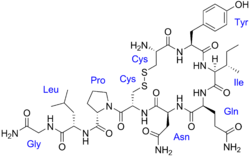
Back أوكسيتوسين (دواء) Arabic Oxitocina (medicación) Spanish اکسیتوسین (دارو) Persian אוקסיטוצין (תרופה) HE Oxytocin (dược phẩm) Vietnamese 催產素 (藥物) Chinese
This article needs more reliable medical references for verification or relies too heavily on primary sources. (January 2024) |  |
 | |
 | |
| Clinical data | |
|---|---|
| Pronunciation | /ˌɒksɪˈtoʊsɪn/ |
| Trade names | Pitocin, Syntocinon, Viatocinon, others |
| AHFS/Drugs.com | Monograph |
| MedlinePlus | a682685 |
| License data | |
| Pregnancy category |
|
| Routes of administration | Intranasal, intravenous, intramuscular |
| ATC code | |
| Legal status | |
| Legal status | |
| Pharmacokinetic data | |
| Metabolism | Liver and elsewhere (via oxytocinases) |
| Elimination half-life | 1–6 min (IV) ~2 h (intranasal)[4][5] |
| Excretion | Bile duct and kidney |
| Identifiers | |
| |
| CAS Number | |
| PubChem CID | |
| IUPHAR/BPS | |
| DrugBank | |
| ChemSpider | |
| UNII | |
| KEGG | |
| ChEBI | |
| ChEMBL | |
| Chemical and physical data | |
| Formula | C43H66N12O12S2 |
| Molar mass | 1007.19 g·mol−1 |
| 3D model (JSmol) | |
| |
| |
| (verify) | |
Synthetic oxytocin, sold under the brand name Pitocin among others, is a medication made from the peptide oxytocin.[6][7] As a medication, it is used to cause contraction of the uterus to start labor, increase the speed of labor, and to stop bleeding following delivery.[6] For this purpose, it is given by injection either into a muscle or into a vein.[6]
Oxytocin is also available in intranasal spray form for psychiatric, endocrine and weight management use as a supplement. Intranasal oxytocin works on a different pathway than injected oxytocin, primarily along the olfactory nerve crossing the blood–brain barrier to the olfactory lobe in the brain, where dense magnocellular oxytocin neurons receive the dose application.
The use of synthetic oxytocin as an injectable medication for inducing childbirth can result in excessive contraction of the uterus that can risk the health of the baby.[6] Common side effects in the mother include nausea and a slow heart rate.[6] Serious side effects include rupture of the uterus and with excessive dose, water intoxication.[6] Allergic reactions including anaphylaxis may also occur.[6]
The natural occurrence of oxytocin was discovered in 1906.[8][9] It is on the World Health Organization's List of Essential Medicines.[10]
- ^ "Syntocinon 10 IU/ml Concentrate for Solution for Infusion". (emc). 25 October 2023. Retrieved 14 January 2024.
- ^ "Pitocin- oxytocin injection". DailyMed. 10 January 2008. Retrieved 14 January 2024.
- ^ "Oxytocin injection, solution". DailyMed. 16 October 2023. Retrieved 14 January 2024.
- ^ Cite error: The named reference
pmid22436536was invoked but never defined (see the help page). - ^ Cite error: The named reference
pmid22467107was invoked but never defined (see the help page). - ^ a b c d e f g "Oxytocin". The American Society of Health-System Pharmacists. Archived from the original on 20 May 2015. Retrieved 1 June 2015.
- ^ The Oxford Handbook of Prosocial Behavior. Oxford University Press. 2015. p. 354. ISBN 978-0-19-539981-3. Archived from the original on 1 August 2017.
- ^ Hurlemann R, Grinevich V (2018). Behavioral Pharmacology of Neuropeptides: Oxytocin. Springer. p. 37. ISBN 978-3-319-63739-6.
- ^ Cite error: The named reference
pmid16992821was invoked but never defined (see the help page). - ^ World Health Organization (2023). The selection and use of essential medicines 2023: web annex A: World Health Organization model list of essential medicines: 23rd list (2023). Geneva: World Health Organization. hdl:10665/371090. WHO/MHP/HPS/EML/2023.02.